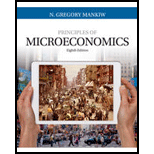
Bundle: Principles of Microeconomics, Loose-leaf Version, 8th + MindTap Economics, 1 term (6 months) Printed Access Card
8th Edition
ISBN: 9781337379151
Author: N. Gregory Mankiw
Publisher: Cengage Learning
expand_more
expand_more
format_list_bulleted
Question
Chapter 20, Problem 6PA
Subpart (a):
To determine
The different views for the redistribution of income.
Subpart (b):
To determine
The different views for the redistribution of income.
Subpart (c):
To determine
The different views for the redistribution of income.
Expert Solution & Answer
Want to see the full answer?
Check out a sample textbook solution
Students have asked these similar questions
Suppose there are two possible income distributionsin a society of ten people. In the first distribution,nine people have incomes of $60,000 and one personhas an income of $20,000. In the second distribution,all ten people have incomes of $50,000.a. If the society had the first income distribution,what would be the utilitarian argument forredistributing income?b. Which income distribution would Rawls considermore equitable? Explain.c. Which income distribution would Nozick considermore equitable? Explain.
Which of the following is an example of a positive economic statement?
a.The government should not be involved in the income redistribution schemes.
b.The after-tax distribution of income is more equal than the pre-tax distribution of income.
c.The distribution of income in the United States should be more equal.
d.The tax system should be more progressive so that the after-tax distribution of income can be more equal.
Suppose that a society contains only two members, a lawyer named Monique and a handyman named James. Five years ago, Monique made $100,000 while James made $50,000. This year, Monique will make $300,000 while James will make $100,000. Which of the following statements about this society’s income distribution are true? a. In absolute dollar amounts, the entire distribution of income has been moving upward. b. In absolute dollar amounts, the entire distribution of income has been stagnant. c. The relative distribution of income has become more equal. d. The relative distribution of income has become less equal. The relative distribution of income has remained constant. f. The rich are getting richer while the poor are getting poorer. g. The rich are getting richer faster than the poor are getting richer.
Chapter 20 Solutions
Bundle: Principles of Microeconomics, Loose-leaf Version, 8th + MindTap Economics, 1 term (6 months) Printed Access Card
Knowledge Booster
Similar questions
- The Lorenz curve is used to show which of the following? a. The total income generated from all activities b. The degree of inequality in the distribution of income within a country c. The progressivity of the income-tax structure within a country d. The extent of wage differences among workers in similar occupations e. The change in the poverty rate within a country over timearrow_forwardIf there are two communities, one with ten families have incomes of $100,000 each and ten families have incomes of $20,000 each. In the other community, ten families have incomes of $250,000 each and ten families have incomes of $25,000 each. Which community is the distribution of income more unequal? In which community is the problem of poverty likely to be worse?Which distribution of income would Rawls prefer? Explain.Which distribution of income do you prefer? Explain.Why might someone have the opposite preference?arrow_forward
Recommended textbooks for you
 Microeconomics: Private and Public Choice (MindTa...EconomicsISBN:9781305506893Author:James D. Gwartney, Richard L. Stroup, Russell S. Sobel, David A. MacphersonPublisher:Cengage Learning
Microeconomics: Private and Public Choice (MindTa...EconomicsISBN:9781305506893Author:James D. Gwartney, Richard L. Stroup, Russell S. Sobel, David A. MacphersonPublisher:Cengage Learning Economics: Private and Public Choice (MindTap Cou...EconomicsISBN:9781305506725Author:James D. Gwartney, Richard L. Stroup, Russell S. Sobel, David A. MacphersonPublisher:Cengage Learning
Economics: Private and Public Choice (MindTap Cou...EconomicsISBN:9781305506725Author:James D. Gwartney, Richard L. Stroup, Russell S. Sobel, David A. MacphersonPublisher:Cengage Learning

 Exploring EconomicsEconomicsISBN:9781544336329Author:Robert L. SextonPublisher:SAGE Publications, Inc
Exploring EconomicsEconomicsISBN:9781544336329Author:Robert L. SextonPublisher:SAGE Publications, Inc

Microeconomics: Private and Public Choice (MindTa...
Economics
ISBN:9781305506893
Author:James D. Gwartney, Richard L. Stroup, Russell S. Sobel, David A. Macpherson
Publisher:Cengage Learning

Economics: Private and Public Choice (MindTap Cou...
Economics
ISBN:9781305506725
Author:James D. Gwartney, Richard L. Stroup, Russell S. Sobel, David A. Macpherson
Publisher:Cengage Learning



Exploring Economics
Economics
ISBN:9781544336329
Author:Robert L. Sexton
Publisher:SAGE Publications, Inc
